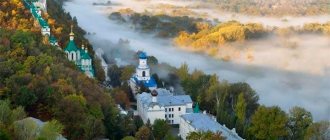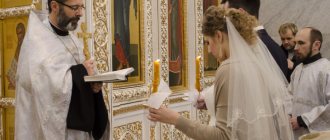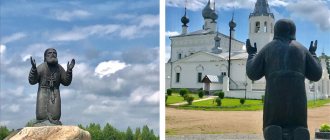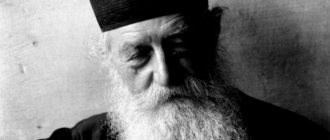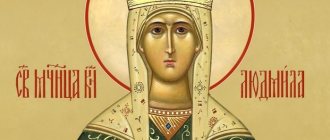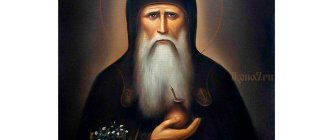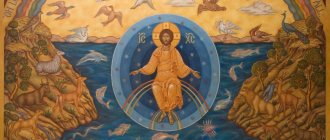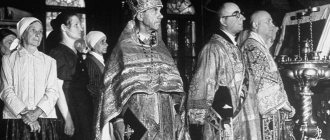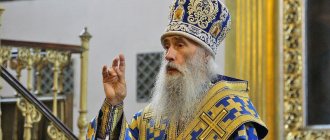| Sofia Patriarchal Cathedral in the name of St. blgv. Prince Alexander Nevsky. 2006 |
Bulgarian Orthodox Church
(or
Bulgarian Patriarchate
), autocephalous local Church
- Official site:
- Canonical territory: Bulgaria; in the “diaspora” it is most represented in the USA and Germany, also in Western European countries, Canada, Australia; in the canonical territory of several local Churches he is in charge of parishes for Bulgarians
- Liturgical language: Church Slavonic and Bulgarian
- Calendar: main New Julian, in some cases Julian [1]
- Cathedral: Alexander Nevsky in Sofia (also in Sofia and the residence of the primate)
- Primate: Neophyte, His Holiness Patriarch of Bulgaria, Metropolitan of Sofia
- Place in the diptych: 9 (Rus.) or 8 (Const.)
- Composition: 31 bishops; 15 dioceses; more than 1,500 clergy (end 2008) [2]; OK. 2600 parishes (end 2008) [3]; OK. 120 monasteries (end 2008) [4]; 4 higher theological schools; OK. 4.374 million members (2011) [5]
Canonical device
The supreme ecclesiastical legal and administrative power belongs to the Holy Synod, which includes the patriarch and all metropolitans.
Legislative power belongs to the Church Council, which includes all serving bishops, representatives of the clergy and monastics, as well as a certain number of laity. The new Statute of the Bulgarian Orthodox Church was adopted at the IV Church-People's Council of the Church in December 2008. The Bulgarian Orthodox Church is organized as a Patriarchate and is divided into metropolitanates, which are independent dioceses headed by bishops with the rank of metropolitans. There are a number of suffragan sees headed by bishops.
| Dioceses of the Bulgarian Orthodox Church. Compiled by Pakko, August 11, 2008 |
Dioceses
See also Episcopate of the Bulgarian Orthodox Church; Historical dioceses of the Bulgarian Orthodox Church
- Sofia
- Varna
- Veliko Tarnovskaya
- Vidinskaya
- Vrachanskaya
- Dorostolskaya
- Lovechskaya
- Nevrokopskaya
- Plevenskaya
- Plovdivskaya
- Slivenskaya
- Starozagorskaya
- Rusenskaya
- In the "diaspora":
- American
- Western European
Protestantism is actively developing in Bulgaria
Like many post-Soviet countries, Protestantism is actively developing in Bulgaria. It ranks second in number among the denominations of this country.
So in 2011 there were 64.5 thousand Protestants in the country. This is quite a large figure.
Methodist church in the Bulgarian city of Pleven. Protestants entered Bulgaria along with American missionaries. Photo: upload.wikimedia.org
Protestantism came to Bulgaria through American missionaries in the 19th century. They belonged to such movements as Methodism (in the north) and Congregationalism (in the south). The first Protestant community appeared in 1868 in the city of Bansko.
In 1875, the Bulgarian Evangelical Charitable Society appeared, later renamed the Union of Evangelical Churches in Bulgaria.
It was this union that translated the Bible into modern Bulgarian. A little later, Adventists and Baptists arrived in the country. In 1921, Russian emigrants brought Pentecostalism to Bulgarian soil.
1992
starting this year, the persecution of Protestants in Bulgaria has stopped
The majority of modern Bulgarian Protestants are Pentecostals. The Pentecostal movement in the country is developing rapidly and a significant part of the converts are local Roma.
About 500 churches and 25 thousand believers are united in the Union of Evangelical Pentecostal Churches (operating since 1928; part of the Assemblies of God) Another 180 churches and 3.6 thousand believers represent the Bulgarian Church of God (operating since 1982; part of the Church of God) .
Some Pentecostals and charismatics are united in the Bulgarian Free Church. There are parishes of the Redeemed Christian Church of God in Sofia, Pleven and Stavertsi.
Todor Zhivkov. 3rd General Secretary of the Central Committee of the BCP. During the reign of the communist regime in Bulgaria, Protestants were persecuted in the country, led by the leader of the Bulgarian communists. Photo: upload.wikimedia.org
In 2011, the Adventist Church of Bulgaria united 7.6 thousand members and 118 churches. There are also marginal Christian groups in the country.
During the reign of the communist regime in Bulgaria, Protestantism was persecuted by local authorities. Since 1992, all persecution has stopped and this denomination is developing absolutely freely.
Historical sketch
On the territory of modern Bulgaria, Christianity began to spread from apostolic times. According to legend, there were episcopal sees in the city of Odiss (now Varna), where the bishop was the disciple of the Apostle Paul, Apostle Amplius, and in Philippopolis of Thracia (now Plovdiv), where the Apostle Hermas was a bishop. In the century there were also episcopal sees in the cities of Debelt and Anchial. In the centuries, Christianity began to spread among the Balkan Slavs who settled the territory of modern Bulgaria and often served as mercenaries in the armies of Byzantium.
In the 670s, the Turkic-speaking Mlemen of the Bulgarians, led by Khan Asparukh, invaded the territory of modern Bulgaria. Christianity penetrated into their midst much more difficultly than among the Slavs. However, in the 8th centuries there was a merger of these two ethnically heterogeneous elements living in a mixture: as a result, the Turkic-speaking Bulgarians were assimilated linguistically and culturally by the Slavs, although the name Bulgarians was assigned to the people, and the country Bulgaria.
The general baptism of the Bulgarian people took place in 865, under the Holy Prince Boris I.
In 870, the Bulgarian Church received autonomy within the Patriarchate of Constantinople and enjoyed broad internal self-government. From 919 it became autocephalous, and in 927 it became a Patriarchate with its center in Ohrid. This ecclesiastical independence was constantly challenged by Byzantium. Since the 14th century Bulgaria found itself under the rule of the Turks and again became dependent on Constantinople, autocephaly was abolished, the church began to be governed by Greek bishops who sought to oust the Church Slavonic language from worship and completely Hellenize the church. In an effort to counteract this, the Bulgarians insisted on autocephaly. Many Patriarchs of Constantinople tried to resolve this difficult issue, but due to the pressure exerted by the Balkan Greeks, they did not succeed.
After a stubborn struggle, independence was arbitrarily restored. In 1860, the Bulgarian bishops broke away from Constantinople and obtained permission from the Turkish Sultan to create a separate Bulgarian exarchate. On this occasion, Patriarch Anthimus I of Constantinople convened a local council in Constantinople (1872), which was also attended by the Patriarchs of Alexandria and Antioch. By the decision of this council, the Bulgarian exarchate was banned, and the Bulgarian autocephaly was declared schismatic by the Patriarchate of Constantinople. Only in 1945 was the schism lifted, and in 1953 the Bulgarian Church became the Patriarchate.
In 1994, a schism occurred in the Bulgarian Orthodox Church led by Metropolitan Pimen of Nevrokop, 2 bishops and part of the clergy formed their own synod and announced the deposition of Patriarch Maxim. The Holy Synod of the Bulgarian Orthodox Church condemned the schismatics, depriving them not only of their rank, but also of monasticism, but they did not recognize the resolutions of the synod.
The first Catholics appeared in Bulgaria during the rule of the Turks in the country
Catholicism is the third largest religion in Bulgaria after Orthodoxy and Islam. Belongs to the Greek Catholic Church.
Chronicles say that representatives of Catholicism appeared in the country in the 14th century during the rule of the Turks, while Bulgarian Catholics are divided into three groups, different from each other in their historical origin.
The Cathedral of St. Louis in Plovdiv is one of the Catholic shrines in Bulgaria. Catholics appeared in the country during the reign of the Turks. Photo: upload.wikimedia.org
The first group includes the descendants of Saxon miners who lived in the north-west of the country and immigrants from the colonies of Ragusa, along with other western settlers. The second group includes the descendants of the Paulicans or Banat Bulgarians who converted to Catholicism.
The third group includes Bulgarians who converted to Catholicism in various historical periods and are Orthodox. Most of them belong to Greek Catholics.
XIV
Catholics appeared in Bulgaria in this century
The 2011 census shows that 48,945 people (0.85% of the population) of the Roman Catholic faith live in Bulgaria. Catholic directories give a figure of about 60,000 Latin Rite Catholics.
The country's Greek Catholics are united in the Bulgarian Greek Catholic Church, their number is about 10,000 people.
Residence of the head of the Bulgarian Greek Catholic Church in Sofia. The Bulgarian Greek Catholic Church unites Bulgarian Greek Catholics. Photo: upload.wikimedia.org
In total, there are 2 Catholic dioceses of the Latin rite in Bulgaria - the diocese of Nikopol and the diocese of Sofia-Plovdiv.
They are not united into a metropolitanate and both have the status of diocese of direct subordination to the Holy See. The Bulgarian Greek Catholic Church has the status of an apostolic exarchate, its center is in Sofia.
Catholic churches and cathedrals have been built in the country: in Sofia, Plovdiv and other cities.
Primates
[6]
Archbishops
Patriarchs
- Damian (927 - after 971)
- Herman (late 10th century)
- Philip (late 10th century - early 11th century)
- David (1016 - 1018)
- John (1018 - 1019)
- see further Archbishops of Ohrid
Archbishops of Tarnovo
- Basil I (1186/87 - after 1230)
- Vissarion
Patriarchs of Tarnovo
- St. Joachim I (1235 -1246)
- Vasily II (1246 - ?)
- Joachim II (c. 1265)
- Ignatius (before 1273 - after 1277)
- sschmch. Macarius
- Joachim III (1280s - 1300)
- Dorofei
- Novel
- Theodosius I (c. 1337)
- Ioannikios I
- Simeon (c. 1346)
- Theodosius II (c. 1348 - c. 1360)
- Joannicius II (c. early 1360s - c. 1375)
- St. Euthymius (1375 -1393)
Exarchs of Bulgaria
- Hilarion (Ivanov) (February 12-16, 1872)
- Anfim (Chalykov) (February 16, 1872 - June 17, 1877)
- Joseph (Yovchev) (April 24, 1877 - June 20, 1915)
- Parfeniy (Ivanov) (1915 - June 20, 1918) Metropolitan. Sofia, Viceroy-Chairman of the Holy Synod
- Vasily (Mikhailov) (June 1918 - October 1921) Metropolitan. Dorostolo-Chervensky, Viceroy-Chairman of the Holy Synod
- Maxim (Pelov) (October 22, 1921 - March 28, 1928) Metropolitan. Plovdivsky, Viceroy-Chairman of the Holy Synod
- Kliment (Shivachev) (March 28, 1928 - May 3, 1930) Metropolitan. Vrachansky, Vice-Chairman of the Holy Synod
- Neophyte (Karaabov) (May 4, 1930 - October 15, 1944) Metropolitan. Vidinsky, Viceroy-Chairman of the Holy Synod
- Stefan (Shokov) (October 16, 1944 - January 21, 1945) Metropolitan. Sofia, Viceroy-Chairman of the Holy Synod
- Mikhail (Chavdarov) (November 8, 1948 - January 4, 1949) Metropolitan. Dorostolo-Chervensky, Viceroy-Chairman of the Holy Synod
- Paisiy (Ankov) (January 4, 1949 - January 3, 1951) Metropolitan. Vrachansky, Vice-Chairman of the Holy Synod
Bulgarian Patriarchs
- Kirill (Konstantinov) (January 3, 1951 - May 10, 1953) Metropolitan. Plovdivsky, Viceroy-Chairman of the Holy Synod
- Maxim (Minkov) (March 13 - July 4, 1971) Metropolitan. Lovechsky, Viceroy-Chairman of the Holy Synod
- Kirill (Kovachev) (November 10, 2012 - February 24, 2013) Metropolitan. Varnensky, Viceroy-Chairman of the Holy Synod
Historical titles of the primate
- Patriarch of Bulgaria, Metropolitan of Sofia (from May 8, 1953 - mentioned 2013)
Dioceses
Dioceses in Bulgaria: (original
Bulgarian names in brackets)
- Diocese of Vidin (Diocese of Vidin)
- Diocese of Vratsa (Diocese of Vratsa)
- Eparcia de Lovech (Diocese of Lovech)
- Diocese of Veliko Tarnovo (Diocese of Tarnovo)
- Eparquía de Dorostol Diocese of Dorostol) (seated in Silistra)
- Eparquía de Varna y Veliki Preslav (Varna and Belikopreslav Diocese) (seat in Varna)
- Eparquía de Sliven (Diocese of Sliven)
- Diocese of Stara Zagora (Diocese of Stara Zagora)
- Eparquía de Plovdiv (Diocese of Plovdiv)
- Diocese of Sofia (Diocese of Sofia)
- Eparquía de Nevrokop Nevrokop diocese) (seated in Blagoevgrad)
- Eparquía de Pleven Diocese of Pleven)
- Eparquía de Rousse (Russian Diocese)
Foreign dioceses:
- Diocese of Central and Western Europe (headquarters in Berlin);
- Diocese of the USA, Canada and Australia (headquarters in New York)
Saints and shrines
In the Bulgarian Church they are especially revered: Saint Prince Boris - the baptizer of the Bulgarian people; the holy Equal-to-the-Apostles brothers Cyril (+ 869) and Methodius (+ 885) - the creators of Slavic writing, who translated the books of Holy Scripture and liturgical books into the Slavic language; Saint Clement of Ohrid (+ 916) - one of the disciples of the holy brothers; Patriarch of Tarnovo Saint Euthymius (XIV century), whose ministry was aimed at the spiritual growth of the Church and strengthening the country; the abbot of the Hilendar monastery, the Monk Paisius (+ 1798) and the bishop of Vratsa, Saint Sophronius (+ 1813), glorified in 1964. The founder of one of the most famous monasteries, St. John of Rila (+ 946), is revered as the heavenly patron of Bulgaria.
Spiritual education in the Bulgarian Orthodox Church
There are two theological seminaries here - in Sofia and in Plovdiv. In these institutions, as everyone knows, priests are trained - future church shepherds and exemplary Christians. However, it is not only in these educational institutions that spiritual disciplines can be mastered.
Some universities in Bulgaria have theological faculties, where you can also receive spiritual education. Such institutions are the Sofia University of St. Clement of Ohrid, the oldest university in the state, as well as the Veliko Tarnovo University named after Saints Cyril and Methodius.
We recommend reading: Essay on the topic of the first snow Discussion about love for a person The main characters of “Fahrenheit 451”
Stauropegia
- Bachkovo Monastery
- Rila Monastery
- Troyan Assumption Monastery (since 1830 - stauropegy of the Patriarch of Constantinople)
- St. Sophia Alexander Nevsky Cathedral, patriarchal cathedral monument
- Sofia Ioanno-Rila Seminary Church
- Plovdiv Cyril and Methodius Seminary Church
- Former stauropegians:
- Pomorie St. George Monastery (? - 2008)
- Transfiguration Monastery on Yantra (? - 2008)
Troyan Monastery
The third largest monastery in Bulgaria is located 10 km from the beautiful town of Troyan, Central Stara Planina (Old Mountain). Although the monastery was founded in the 16th century, it was only the beginning of the 19th century that really saw the formation of a remarkable architectural complex.
The monastery chronicle, compiled in 1835, says: “The Troyan monastery arose many years after the fall of the Bulgarian kingdom...
Then there was a huge renovation, which was a great opportunity for some of the best Bulgarian builders, artists, wood carvers to show off their impressive skills. All of them, especially Zachary Zograf, decorated the main church of the complex with portraits of Bulgarian rulers, patrons, and patriots.
The monastery also contains a rich collection of icons, including a special icon of St. George, the miraculous icon of the Three-Headed Mother of God, brought from Mt. Athos, dating back to the 16th century.
External Relations
Close ties are maintained with the Zograf Monastery on Mount Athos, populated predominantly by Bulgarians.
Institutions on the canonical territory of other local Churches:
- Bulgarian church community in Istanbul, in charge of the Orthodox Bulgarians of Turkey, on the territory of the Church of Constantinople
- Moscow courtyard, representation under the Patriarch of Moscow and All Rus'
- The Western European diocese includes:
- On the territory of the Serbian Church: Zagreb Church of the Seventh Day
- On the territory of the Czechoslovak Church: Prague St. Nicholas Church, Bratislava St. John the Baptist Church
Islam is the second largest religion in Bulgaria
In the territory of the Republic of Bulgaria, Islam is considered the second largest and most important religion. From the 14th to the mid-19th century, Islam occupied a leading place in the life and culture of the country.
XIV-XIX
in these centuries the leading religion in Bulgaria was Islam
It is worth noting that the majority of the country's Slavic population continued to adhere to Orthodoxy even during the zenith of the Ottoman Empire. Despite this, many local Bulgarians, as well as Greeks and Gypsies, converted to Islam, mainly for domestic reasons.
For a long time, Muslims constituted the main population of Bulgarian cities, since here they were protected from attacks by the Haiduks.
Mosque in Sofia. The Sofia Mosque is the oldest mosque in Europe. Photo: upload.wikimedia.org
At the end of the 18th century, after Bulgaria gained sovereignty, mass emigration of Muslims (Muhajirism) began. As a result, compact Muslim settlements in our time have survived only in the northeast and southeast of the country, near the border with Turkey.
In addition, in 1989, the so-called Renaissance process began. It consisted in the Bulgarianization of the country and its entry, many Muslims left the country. In modern times, a significant Muslim community remains in southeast Bulgaria.
In the capital of the country - the city of Sofia - Muslims are now small in number, but there is one mosque, Banya Bashi (1576). This is the oldest mosque in Europe. There are much more mosques in provincial cities.
Bulgaria has the largest autochthonous Muslim community in Europe.
Bulgaria is considered to be the first country in the European Union to have such a significant proportion of indigenous Muslim population. As of 2001, 966,978 Muslims lived here (or 12.3% of the country's population).
If we take the ethnic composition of Bulgarian Muslims, then these are Turks, Muslim Bulgarians (Pomaks), Muslim Gypsies, Bosnians, Albanians, Arabs, etc. Followers of Islam are divided into Sunnis - a minority of believers, and Shiites - the majority.
Klisursky Monastery
90 kilometers north of Sofia, not far from the road leading to the resort town of Varshets, the Klisura monastery nestles under the pine-lined eastern slopes of the Todorini Kukli peak in Western Stara Planina. Founded in 1240 and completely restored in the 1990s, the monastery's whitewashed buildings and lovely courtyard create the perfect atmosphere of rural tranquility.
In the center of the monastery complex there is a spring with healing water. The Klisursky Monastery is active, several dozen nuns permanently live here
This is the real attraction, not the architecture, murals or historical significance of the place. Due to its location, the monastery is often considered a good starting point for hikes on the mountain.
